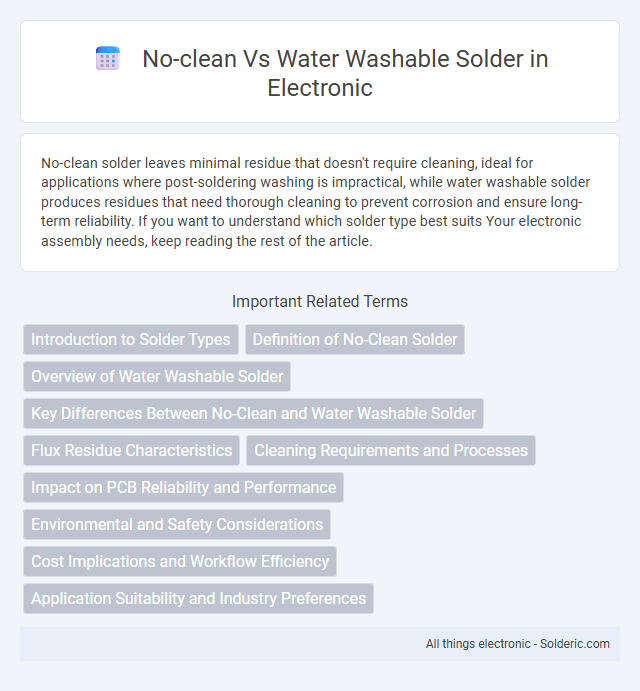No-clean solder leaves minimal residue that doesn't require cleaning, ideal for applications where post-soldering washing is impractical, while water washable solder produces residues that need thorough cleaning to prevent corrosion and ensure long-term reliability. If you want to understand which solder type best suits Your electronic assembly needs, keep reading the rest of the article.
Comparison Table
| Feature | No-Clean Solder | Water Washable Solder |
|---|---|---|
| Flux Residue | Minimal, non-conductive, no cleaning required | Residue must be cleaned with water after soldering |
| Cleaning Process | No cleaning needed, reduces post-process time | Requires thorough water rinsing or cleaning system |
| Environmental Impact | Less water usage, possible mild chemical residues | Higher water consumption but generally more environmentally friendly |
| Application | Ideal for electronics sensitive to moisture | Best for robust electronics where cleaning is feasible |
| Cost | Typically higher material cost, lower cleaning cost | Lower material cost, higher cleaning process cost |
| Reliability | Stable residues, less corrosion risk | Clean surface with no residue after washing, reduces corrosion risk |
| Process Complexity | Simpler, faster production with no cleaning stage | Additional cleaning step increases process time and complexity |
Introduction to Solder Types
No-clean solder flux leaves minimal residue that does not require cleaning, making it ideal for electronics where post-solder cleaning is impractical. Water washable solder flux, on the other hand, produces residues that are corrosive or conductive and must be removed using water-based cleaning processes to ensure device reliability. Selecting between no-clean and water washable solder depends on factors such as assembly complexity, environmental concerns, and cleaning capabilities within the manufacturing process.
Definition of No-Clean Solder
No-clean solder uses flux designed to leave minimal, non-conductive, and non-corrosive residue on your circuit boards, eliminating the need for post-solder cleaning. This type of solder simplifies manufacturing by reducing cleaning steps and associated costs, making it ideal for small electronics or sensitive components. Understanding the properties and applications of no-clean solder helps optimize your assembly process based on residue tolerance and environmental considerations.
Overview of Water Washable Solder
Water washable solder flux is designed to be fully removed with water after the soldering process, leaving minimal residue on the PCB. This type of solder flux enhances reliability in electronics manufacturing by preventing corrosion and electrical leakage associated with flux residues. Using water washable solder allows you to maintain cleaner assemblies without the need for harsh solvents, improving environmental compliance and production efficiency.
Key Differences Between No-Clean and Water Washable Solder
No-clean solder leaves minimal residue that does not require cleaning, making it ideal for processes where post-soldering cleaning is impractical or costly, while water washable solder produces flux residues that must be thoroughly rinsed off with water to prevent corrosion or electrical failures. Water washable solder requires more rigorous cleaning equipment and processes, increasing manufacturing time and maintenance, whereas no-clean solder supports faster production cycles with reduced environmental impact from cleaning chemicals. Selecting the appropriate solder depends on your product's reliability requirements, cleaning capabilities, and regulatory compliance considerations.
Flux Residue Characteristics
No-clean solder flux residue is minimal and non-corrosive, designed to remain on the PCB without requiring removal, making it ideal for applications where cleaning is difficult or costly. Water washable solder flux leaves more pronounced, sticky residue that must be thoroughly cleaned to prevent corrosion, electrical shorts, and reliability issues. Understanding your assembly's cleaning capabilities and residue impact is essential to selecting the appropriate flux type for optimal solder joint quality and long-term performance.
Cleaning Requirements and Processes
No-clean solder flux leaves minimal residue that generally requires no cleaning, making it ideal for applications where post-soldering washing is impractical or may damage sensitive components. Water-washable solder flux generates residues that are corrosive or conductive, necessitating immediate cleaning with deionized water and specialized equipment to prevent long-term circuit failure. Selecting the appropriate solder flux impacts your manufacturing process efficiency by balancing cleaning complexity against reliability and environmental considerations.
Impact on PCB Reliability and Performance
No-clean solder flux residues are designed to be minimally corrosive and electrically benign, reducing the risk of long-term PCB reliability issues like residue-induced corrosion or electrical leakage. Water washable solder fluxes require thorough cleaning to remove residues that could otherwise degrade PCB performance through ionic contamination or corrosion over time. Choosing the right flux type affects your PCB's lifespan, ensuring optimal electrical performance and mitigating potential reliability failures caused by flux residues.
Environmental and Safety Considerations
No-clean solder flux leaves minimal residue, reducing the need for solvents and limiting environmental impact, but its residues can sometimes be corrosive or conductive, potentially posing long-term safety risks. Water washable solder flux requires rinsing with water, which increases water usage and wastewater treatment needs, yet it removes flux residues effectively, enhancing device reliability and reducing exposure to harmful chemicals. Your choice should balance environmental sustainability with safety priorities, considering factors like waste management and potential skin or respiratory exposure during manufacturing.
Cost Implications and Workflow Efficiency
No-clean solder flux reduces costs by eliminating the need for post-solder cleaning processes, lowering labor and solvent expenses while shortening production cycles. Water washable solder flux demands additional cleaning steps, increasing operational costs and extending workflow duration due to water-based cleaning equipment and drying time. Manufacturers weigh these factors to optimize budget and throughput, often choosing no-clean flux for high-volume production where cost efficiency and faster turnaround are critical.
Application Suitability and Industry Preferences
No-clean solder flux is favored in electronics manufacturing for applications requiring minimal post-soldering cleaning, particularly in consumer electronics and high-volume production where residue can be left on boards without affecting performance. Water washable solder flux is preferred in industries such as aerospace and medical devices where strict cleanliness standards demand thorough residue removal to ensure reliability and performance. Your choice should consider industry-specific regulations and the operational environment to ensure optimal application suitability and compliance.
no-clean vs water washable solder Infographic

 solderic.com
solderic.com